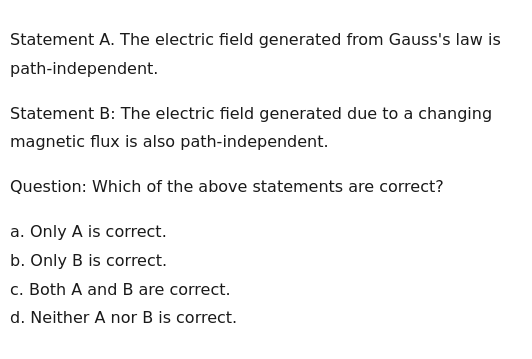Question
Question: Statement A. The electric field generated from Gauss's law is path-independent. Statement B: The el...
Statement A. The electric field generated from Gauss's law is path-independent.
Statement B: The electric field generated due to a changing magnetic flux is also path-independent.
Question: Which of the above statements are correct?

Only A is correct.
Only B is correct.
Both A and B are correct.
Neither A nor B is correct.
Only Statement A is correct.
Solution
Statement A refers to the electrostatic field, which is conservative, meaning the work done by the field (and thus the line integral) is path-independent. Statement B refers to the induced electric field due to changing magnetic flux (Faraday's law), which is non-conservative, meaning the line integral around a closed path is non-zero, implying path-dependence for line integrals between points.
Statement A: The electric field generated from Gauss's law is path-independent. Gauss's law is a fundamental law of electrostatics, dealing with electric fields produced by static charge distributions. The electric field in electrostatics is a conservative field. For a conservative field E, the line integral ∫ABE⋅dl between any two points A and B is independent of the path taken. This property is known as path-independence. Thus, Statement A is correct.
Statement B: The electric field generated due to a changing magnetic flux is also path-independent. According to Faraday's law of electromagnetic induction, a changing magnetic flux induces an electromotive force (EMF), which is associated with an induced electric field. Faraday's law is given by ∮E⋅dl=−dtdΦB. The integral on the left side is the circulation of the electric field around a closed loop. If the magnetic flux ΦB is changing with time (dtdΦB=0), the line integral of the induced electric field around a closed path is non-zero. This property (∮E⋅dl=0) defines a non-conservative field. For a non-conservative field, the line integral between two points is dependent on the path taken. Therefore, the electric field generated due to a changing magnetic flux is path-dependent. Thus, Statement B is incorrect.
